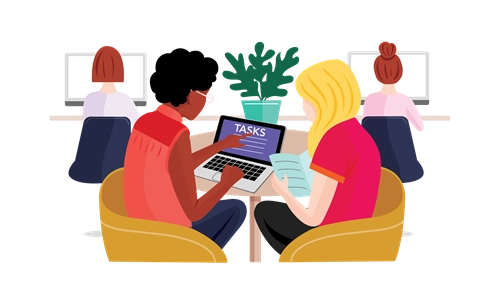7 principles for inclusive learning environments
Overview
Using these principles, you can design lessons that will engage all your students in STEM.
The Classroom strategies for inclusive STEM learning environments guide is a comprehensive document that provides a summary of key research findings aligned to the below 7 Principles for Inclusive STEM Education, with suggested practical strategies and contemporary resources.
The quick reference poster can be downloaded and provides a snapshot of the 7 principles.
Classroom strategies
1. Create a gender-neutral learning environment
A gender-neutral learning environment is not necessarily one that is gender-free. Rather, it’s an environment in which teachers and learners avoid gender stereotyping and aim to ensure that all learners are appreciated, respected and treated equally.
To create a gender-neutral classroom, consider:
- using gender-neutral language to describe groups of students (instead of ‘Now, guys’ consider expressions like, ‘Now, everybody’)
- using gender-neutral language to describe STEM careers and roles
- providing balanced gender representations of STEM careers and roles
- actively identifying stereotypes and biases and creating teachable moments by challenging their accuracy.
2. Ensure everyone gets hands-on
Provide girls with multiple and sustained opportunities to get hands-on, particularly with technology. Girls’ engagement with technology is often more restrictive and less autonomous than boys’, and girls often receive less support and encouragement from parents to use computers and technology products (Vekiri, 2013). Most students find hands-on activities more engaging, but research has shown that girls derive a particular benefit from hands-on and inquiry-based learning (Brotman and Moore, 2008).
'The more practical experiences a girl receives during her education, the higher her interest in STEM' (Microsoft, 2017).
People can develop important skills for STEM fields by undertaking spatially demanding tasks, such as manipulating objects, representing objects from different perspectives, and engaging with a game or simulation that requires spatial skills. Often girls have not spent as much time playing with construction-based toys, and can feel that they lack ‘natural ability’ with spatially demanding tasks (Dearing, Casey, Ganley, Tillinger, Laski and Montecillo, 2012). New research indicates that anyone can improve their skills with spatial training (Sorby, 2009).
Ensure group roles are equally distributed among girls and boys. Check that girls have equal access to, and opportunities to develop, skills with technology and other equipment.
When supporting a girl to use equipment, refrain from doing it for her. Try putting your hands behind your back and using careful questioning to help her understand why something might not be working, and what she might try next or do differently.
3. Design learning experiences to embrace context and problem-solving
Context-based learning is critical to girls’ engagement and perception of what it means to do STEM. Girls want to see the relevance of STEM subjects to their lives and to see their social value (Burke, 2007). Studies have shown that girls’ perceptions of a subject’s relevance affects their attitudes towards that subject (Clewell and Braddock, 2000).
Rather than trying to balance stereotypically male or female contexts, instead look to work from your students’ interests and passions to connect their learning to contexts and problems they find personally meaningful.
Research shows that many students, particularly girls and underrepresented minorities, are interested in ‘helping’ careers (Baker and Leary, 1995; Jones, Howe and Rua, 2000; Miller, Blessing and Schwartz, 2006) and so contexts that demonstrate how STEM can be helpful and make a difference in the world are particularly valuable.
Within these contexts, provide opportunities for students to pursue open-ended, investigative learning that focuses on solving complex or real-world problems. A real-world problem-solving approach creates the much-needed link between STEM professionals and careers that have a positive social impact (Cooper and Heaverlo, 2013).
4. Connect learning to careers and role models
For each topic, context or problem, explore related STEM careers and provide role models. Aim for a gender balance in both historical and contemporary figures. Numerous studies have found that providing girls with positive role models has the potential to reduce stereotypical beliefs (Dasgupta, and Asgari, 2004; Marx and Roman, 2002; Lockwood, 2006; McIntyre, et al, 2005).
Sometimes it’s difficult to find women in science history. Find out why in the article Women have been written out of science history – time to put them back from The Conversation.
Invite STEM professionals and VET and university students into the school to provide insight into their career pathways and current areas of passion. When girls make a personal connection with a STEM role model, particularly someone who comes from similar circumstances, they can reframe their stereotypical view of female STEM practitioners (Buck, Clark, Leslie-Pelecky, Lu and Cerda-Lizarraga, 2008). Research has shown that girls who encounter STEM role models report more passion for all STEM subjects (Microsoft, 2018). For more information about engaging role models, see the section Engage the community.
Research has shown that when girls are exposed to positive STEM role models who look like them, their interest increases, along with an improved self-concept related to STEM fields (Hughes, Nzekwe and Molyneaux, 2013).
5. Engineer collaborative learning
Provide opportunities for social learning and collaboration. Research has shown that girls prefer interaction and cooperative learning over competition (Burke, 2007) and this can have positive implications for their engagement with STEM subjects.
Students often need to be supported to collaborate effectively and equitably. Having group roles can scaffold collaboration. If you are using group roles, be aware of who is taking on which role and ensure that roles are rotated among students. In particular, ensure that girls take on leadership and technical roles, and that boys share recording and presentation roles.
While mixed-ability groups are to be encouraged, avoid placing girls in a pastoral care role where they are responsible for supporting under-achieving students.
6. Provide choice and creative opportunities to demonstrate understanding
Problem-solving, creativity and design have been identified as essential skills in all students’ STEM development (Baine, 2009). Girls value creativity but often perceive STEM subjects and careers as lacking in that area. In a recent study, Accenture found that the opportunity to be creative was the leading career aspiration among girls. However, only 32 associated STEM careers with being creative (Accenture, 2018).
Girls are motivated when they are given opportunities to approach projects their own way, exercising their personal preferences and creativity. Engaging with creative problem-solving also encourages students to embrace failure as part of the learning process, building resilience.
Research has found that even just altering a job title to make it sound like it demands more ingenuity or creativity can boost the number of female applicants.
7. Encourage a growth mindset
Many people, girls included, hold the misconception that success in STEM subjects is the result of natural ability, and that boys have more natural ability in these subjects, particularly maths (Office of the Chief Scientist, 2016). Believing that success is due to natural ability is described as having a ‘fixed mindset’, whereas believing that success is due to effort and persistence is described as having a ‘growth mindset’ (Dweck, 1986). Research has shown that boys tend to attribute success to their own efforts and failure to external factors, whereas girls do the opposite (Dweck, 1986; Murphy, 2000).
Girls benefit from explicit teaching about the difference between fixed and growth mindsets, and from mindful teaching that encourages growth mindsets. Girls’ confidence and performance improves in response to specific, positive feedback on effort, strategies and behaviours, as opposed to natural talent or ability.
You can use this Khan Academy lesson, developed in partnership with Stanford, to introduce students to the concept of a growth mindset.
Classroom strategies for inclusive STEM learning environments: implementation guide
The guide is based on a systematic literature review of research about STEM education engagement, particularly for young girls and women. Key research findings are aligned to the 7 Principles for Inclusive STEM Education, with suggested practical strategies and contemporary resources that teachers can use to bring these critical Principles to life to create an engaging and inclusive STEM classroom.
This project was funded by Education Services Australia and undertaken in collaboration with The University of Adelaide.
7 principles for a gender-inclusive learning environment: quick reference poster
This poster summarises the seven guiding principles. Download your own copy as a quick reference to create an inclusive STEM classroom and lessons.










